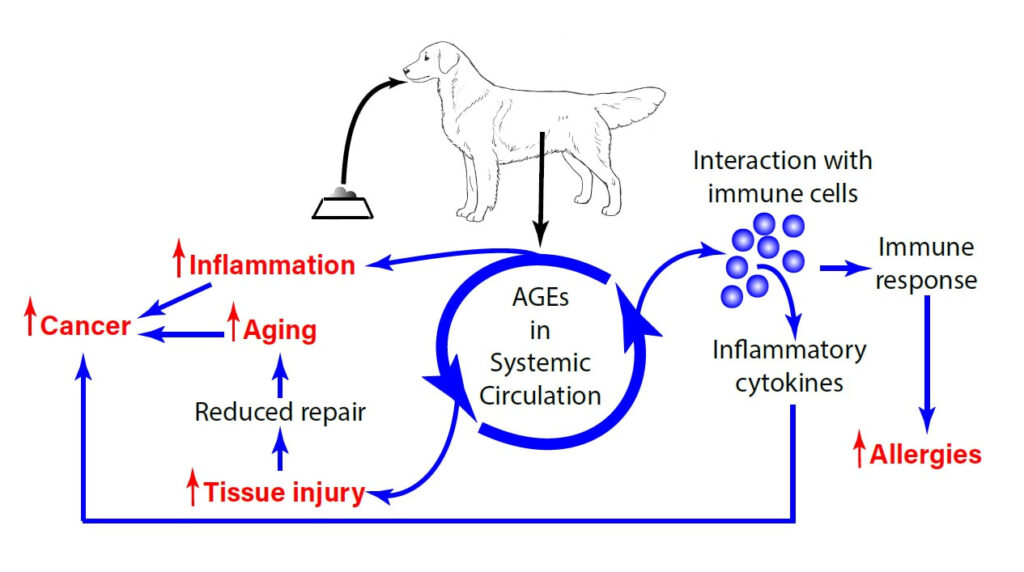
By Chris Zink DVM PhD DACVSMR and co-authored by Donna Raditic DVM DACVN
Fifty years ago, the sugar industry quietly paid researchers at Harvard University to indicate that dietary fat was the major nutritional cause of heart disease (1). Their study was published in the prominent New England Journal of Medicine, and it laid the foundation for decades of nutrition misinformation perpetrated on the public by well-meaning organizations such as the American Heart Association.
Given that there are only three basic components of nutrition – fat, carbohydrates, and protein, of which protein is the most costly– it was inevitable that the emphasis on low-fat diets would lead to greater consumption of sugar. This was a big score for the sugar industry, but not so much for us. We now know that diets high in refined grains and added sugars have numerous detrimental effects on our metabolism, leading to adverse lipid profiles, and contributing to obesity, diabetes, cardiovascular disease, and cancer.
But what does this have to do with dog food?
Dog Food Facts
Dog person that I am, my thoughts then turned to whether high levels of readily digested carbohydrates might also be a problem for dogs, particularly given that nutritionally dogs have a carnivorous bias. Here’s what I learned.
Fact: The majority of dogs in North America (estimates suggest 80 to 90%) are fed kibble.
Fact: On average, kibble contains between 46 and 74% carbohydrates (2).
Fact: Percent carbohydrates required by adult dogs to sustain life: Zero (2).
These facts suggest that it is critically important to understand the role of carbohydrates in kibble dog foods, which contain more carbohydrates than either fat or protein, to be sure that they promote health and longevity for our dogs. As you’ll see, however, it’s not the carbohydrates that are the problem, but how those carbohydrates are processed during the manufacture of kibble.
How Kibble is Made
All kibbles are made in essentially the same way. Wet and dry pet food ingredients, some of which already have gone through heating and other processing, are mixed to form a dough. High pressure and heat are applied to cook the dough which is then forced through tubes. Pieces of the extruded tube-shaped dough are cut off to make pellets. The pellets are then passed through a heated dryer to remove any remaining moisture and the food is sprayed with animal fats to improve flavor, vitamins to attempt to replace those damaged during the heating process, artificial colors to improve visual appeal, and preservatives. That’s how it’s done. Kill off some of the nutrients, then spray them back on. Interestingly, this is also the similar multi-step food processing, termed ‘ultra-processing’ that is used to produce our ready-to-eat-breakfast cereals!
The Maillard Reaction and AGEs (The Whaaat?)
It turns out that the superheating process during the production of kibble changes the quality of some nutrients in a way that no spray can replace (3). When certain amino acids within a protein are heated in the presence of sugars, a series of chemical rearrangements occurs, called the Maillard reaction (4). The final products of this reaction are called advanced glycation end-products or AGEs. This process is irreversible and it actually decreases the availability of certain amino acids in the dog’s food, because they become bound up as part of the AGEs (3).
You Are What You Eat
These AGEs are absorbed in the gut and enter the circulation, where they are distributed to all parts of the body. Because AGEs are big and bulky, they are resistant to degradation, so they accumulate and gradually become part of the protein structure of the entire body (5). Studies are beginning to demonstrate the numerous effects these AGE-modified proteins have on health and disease in both humans and our canine companions.
Here are some of the known effects of AGEs (see Figure for summary):

It turns out that the content of AGEs in processed commercial pet foods is about the same as in processed human foods products. In pet foods, AGE levels in canned food are higher than kibble which are higher than a fresh, minimally processed food. (9, 10) However, the average daily intake by dogs is 122 times higher than that of humans (as a percentage of metabolic body weight) (9)! This is exacerbated by the fact most dogs eat some type of ultra-processed pet food their entire life!
Taken together, these data suggest that by reducing our dogs’ exposure to dietary AGEs we would likely improve their overall health and longevity.
What Can You Do?
Once we learned that heating protein with sugars at high temperatures results in the production of AGEs, and that AGEs contribute to chronic diseases, cancer and aging in dogs, we decided to reduce the exposure of our own dogs to AGEs. For us, that translates to feeding a diet that contains as high a percentage of fresh food as possible and reducing the amount of kibble and canned food that our dogs consume. Human nutritionists tell us to limit our grocery shopping as much as possible to items along the outside walls of the grocery store. These are where the freshest, least processed foods are found. We try to do the equivalent for our dogs.
I know you’d like us to name the specific dog foods we feed. But what’s best for our dogs might not be best for yours. So you’re going to have to do some research. It’s not that different from learning about which are the healthiest foods for yourself and your family. After all, would you spend your entire life eating just one, highly processed food at every meal?
Here are some guidelines to help you get started identifying the best foods for your dog:
Where can you find independent information to help you select the best food for your furry friend? While there is currently no gold-standard source for independent evaluation of dog foods, the Whole Dog Journal is a good start, with monthly issues devoted to reviewing the various forms of dog food. Luckily there is an increasing number of fresh dog foods available on the market, even at the major pet food chains.
It is not our intent to make the reader feel guilty for feeding kibble. We both fed kibble for many years, and still use it for training treats and when traveling. Kibble is convenient and inexpensive as compared to fresh foods. Many dogs have done well on kibble diets for decades. But after learning of the detrimental effects of the products of heat-processed foods on canine metabolism, we decided to try doing just a little better.
We strongly believe that most dogs will benefit from the replacement of at least some portion of their highly processed foods with a fresher alternative. Certainly, the evidence suggests that for dogs with allergies, chronic osteoarthritis, diabetes, or other chronic diseases, replacing highly processed food with a fresher alternative is likely to improve their health and longevity. Why not give it a try?
*Dr. Donna Raditic is a board-certified veterinary nutritionist. As a member of Veterinary Nutritional Consultations, Inc., she provides education and consulting on companion animal nutrition and integrative care. She is also cofounder of the not-for-profit, Companion Animal Nutrition and Wellness Institute that works to fund nutrition education programs and independent nutrition research.
1. Kearns CE, Schmidt LA, Glantz SA. Sugar Industry and Coronary Heart Disease Research: A Historical Analysis of Internal Industry Documents. JAMA Intern Med. 2016;176(11):1680–1685. doi:10.1001/jamainternmed.2016.5394
2. National Research Council, National Academy of Science, “Nutrient Requirements of Dogs and Cats”, 2006 Edition, National Academies Press, Washington, DC, p 317.
3. Teodorowicz M, Hendriks WH, Wichers HJ, Savelkoul HFJ. Immunomodulation by processed animal feed: The role of Maillard reaction products and advanced glycation end-products (AGEs). Frontiers in Immunology 2018;9:2088 doi: 10.3389/fimmu.2018.02088.
4. Hodge JE. Chemistry of browning reactions in model systems. J Agric Food Chem 1953;1:928-43.
5. John WG, Lamb BJ. The maillard or browning reaction in diabetes. Eye 1993;7:230-7.
6. Ramasay R, Vannucci J, Yan D, Herold K, Yan F, Schmidt AM. Advanced glycation end products and RAGE: a common thread in aging, diabetes, neurodegeneration, and inflammation. Glycobiology 2005;15:16-28R. doi: 10.1093/glycob/cwi053.
7. Gentzel JB. Does contemporary canine diet cause cancer? A review. Vet World 2013;6:532-9. Doi: 10.14202/vetworld/2013.632-639.
8. Vlassara H, Bucala R, Striker LJ. Pathogenic effects of advanced glycosylation: biochemical, biologic and clinical implications for diabetes and aging. Lab Invest 1994;70:138-51.
9. van Rooijen C, Bosch G, van der Poel AF, Wierenga PA, Alexander L, Hendriks WH. Quantitation of Maillard reaction products in commercially available pet foods. J Agric Food Chem 2014;62:8883-91. doi: 10.1021/jf502064h.
10. Crissey SD, Swanson JA, Lintzenich BA et al. Use of a raw meat-based diet or a dry kibble for sand cats (Felis margarita). J Anim Sci 1997;75:2154-2160.
Share this article!